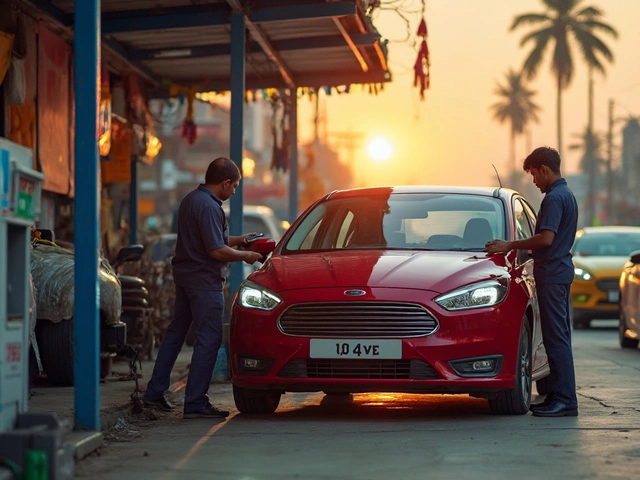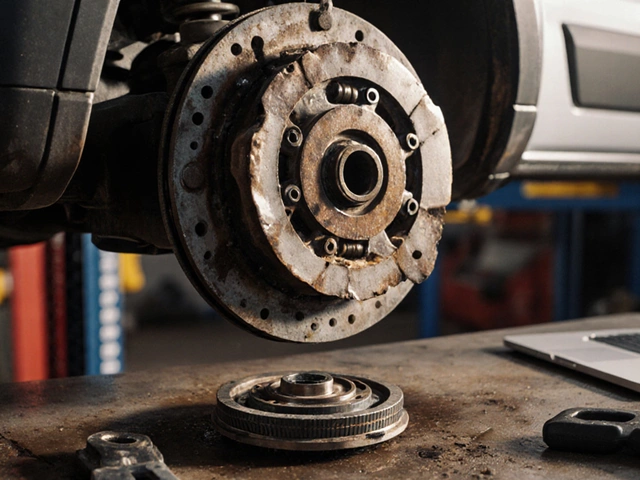
Brake Pad Cost Estimator
Estimate Your Brake Pad Cost
Estimated Cost for 4 Brake Pads
Replacing all four brake pads shouldn’t feel like a mystery. You know your brakes are squealing, grinding, or pulling to one side. You’ve checked online and seen prices ranging from £50 to £500. So what’s the real cost? It’s not about buying the cheapest or the most expensive-it’s about getting the right pads for your car, your driving, and your budget.
What You’re Actually Paying For
When you buy four brake pads, you’re not just buying rubber and metal. You’re paying for:
- Material quality - organic, semi-metallic, or ceramic
- Brand reputation - OEM, premium aftermarket, or budget
- Vehicle compatibility - not all pads fit all cars
- Wear life - some last 20,000 miles, others 50,000+
For example, a set of ceramic brake pads for a Toyota Corolla might cost £85, while the same number of semi-metallic pads for a Ford Focus could be £60. But if you’re driving a BMW 3 Series, those same ceramic pads could jump to £180. The car matters as much as the brand.
Price Breakdown: Budget vs Mid-Range vs Premium
Here’s what you’ll realistically pay for four brake pads in the UK in 2025, based on real shop quotes and online retailer data:
| Quality Tier | Price Range | Best For |
|---|---|---|
| Budget | £40 - £70 | Older city cars, low-mileage drivers |
| Mid-Range | £70 - £130 | Most family cars, regular commuting |
| Premium | £130 - £250+ | Performance cars, high-mileage, towing |
Budget pads from brands like ATE or Mintex often work fine for a 10-year-old Vauxhall Corsa driven 8,000 miles a year. But if you’re hauling kids, groceries, and a bike rack every weekend, those same pads will wear out in 15,000 miles instead of 30,000. You’ll end up paying twice.
Premium pads from Brembo, EBC, or Ferodo are designed for longer life, less dust, and better performance under heat. They’re worth it if you drive on motorways often, live in hilly areas like the Cotswolds, or just hate the sound of squealing brakes at traffic lights.
Why Your Car Model Changes Everything
Not all cars need the same brake pads. A Mini Cooper S has high-performance brakes. A Renault Clio has light-duty ones. The difference isn’t just price-it’s engineering.
For example:
- Toyota Aygo - £45-£65 for 4 pads (small, light car)
- Volkswagen Golf - £80-£120 for 4 pads (standard family car)
- BMW X3 - £160-£220 for 4 pads (heavier, higher performance)
- Land Rover Discovery - £200-£300+ for 4 pads (large, towing-capable)
These aren’t guesses. They’re based on parts listings from Halfords, Amazon UK, and local garages in Bristol. The weight of the vehicle, its top speed, and whether it’s front-wheel or all-wheel drive all affect brake pad size, material, and cost.

Don’t Forget the Hidden Costs
Brake pads aren’t the only thing you’re replacing. Most mechanics will recommend checking or replacing:
- Brake rotors (discs) - if they’re worn or scored
- Brake calipers - if they’re sticking or leaking
- Hardware kits - clips, shims, and anti-rattle parts
- Brake fluid - if it’s been over 2 years since last flush
Replacing just the pads without checking the rotors is like putting new tires on a bent rim. You’ll get noise, vibration, and uneven wear. Rotors often need replacing every second pad change. If your rotors are below 2mm thickness, they’re unsafe.
Labour costs vary. A local independent garage in Bristol charges £60-£90 for a full brake job (pads + rotors + inspection). A main dealer might charge £150-£220. You can save money by doing it yourself-but only if you’ve done it before. Brake systems aren’t DIY-friendly for beginners.
How to Pick the Right Pads Without Getting Ripped Off
Here’s a simple checklist to avoid overpaying or buying the wrong thing:
- Check your car’s manual for OEM part numbers
- Search those numbers online - compare prices across Halfords, Amazon, and Euro Car Parts
- Look for pads with a warranty - most good brands offer 1-2 years
- Avoid the cheapest pads on eBay - they often lack quality control
- Choose ceramic if you want quiet, clean brakes; semi-metallic if you drive hard or tow
- Ask your mechanic: "Do you use OEM-spec pads?" If they hesitate, walk away
Brake pads are one of the few car parts where you really get what you pay for. A £30 set might save you £50 now, but cost you £200 in warped rotors and a brake job next year.

When to Replace Brake Pads
You don’t need to wait until you hear grinding. Signs your pads are worn:
- Squeaking or squealing when braking (especially when wet)
- Brake warning light on dashboard
- More pedal travel - you have to press harder
- Car pulls to one side when braking
- Visible pad thickness less than 3mm (use a flashlight)
Most pads last between 25,000 and 50,000 miles. But if you drive in stop-and-go traffic every day, like in Bristol’s city centre, you might need replacements every 18 months. Highway drivers can go 4-5 years.
What Happens If You Delay
Ignoring worn brake pads doesn’t just make your brakes less effective-it can destroy other parts. When the friction material wears away, the metal backing plate grinds against the rotor. That:
- Scars the rotor - costing £80-£150 per rotor to replace
- Reduces braking power by up to 40%
- Can cause caliper damage or fluid leaks
In the UK, worn brakes are a common cause of MOT failures. If your pads are below 1.5mm, you’ll fail instantly. And if you’re caught driving with dangerously worn brakes, you could face a fine or points on your licence.
Final Advice: Don’t Guess, Measure
Before spending money, get your pads measured. Many garages offer free brake checks. Halfords, Kwik Fit, and local independents will inspect them for free in under 10 minutes. If your pads are at 3mm, plan to replace them soon. At 2mm, do it now.
For most drivers, spending £90-£140 on a mid-range set of ceramic pads is the sweet spot. It’s safe, quiet, long-lasting, and won’t break the bank. And if you’re unsure? Stick with the same brand and type your car came with. OEM specs exist for a reason.
Brakes aren’t where you save money. They’re where you invest.
How much do brake pads cost for a Ford Focus?
For a Ford Focus, four brake pads typically cost between £70 and £120, depending on quality. Budget pads start around £60, while premium ceramic pads can reach £130. Most owners get good results with mid-range options like EBC or Ferodo.
Can I replace brake pads myself?
Yes, if you have basic tools and experience. You’ll need a jack, torque wrench, C-clamp, and brake cleaner. The job takes 1-2 hours per axle. But if you’ve never done it before, mistakes can be dangerous. Improperly installed pads can cause uneven wear or brake failure. If unsure, pay a professional.
Are expensive brake pads worth it?
For most drivers, yes. Premium pads last longer, stop more smoothly, create less dust, and are quieter. If you drive daily, commute on motorways, or carry heavy loads, the extra cost pays off in safety and reduced wear on rotors. For light city driving, mid-range pads are fine.
How often should brake pads be replaced?
Most brake pads last between 25,000 and 50,000 miles. City drivers with lots of stop-and-go traffic may need replacements every 18-24 months. Highway drivers can go 4-5 years. Always check thickness visually - if it’s under 3mm, replace them.
Do all four brake pads wear at the same rate?
No. Front pads wear 2-3 times faster than rear pads because most braking force is on the front axle. It’s common to replace front pads twice before needing to replace rears. Always replace pads in pairs (front or rear set together), never one side at a time.



